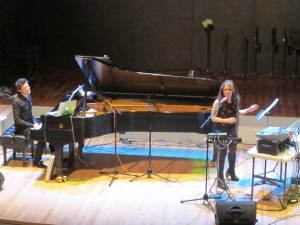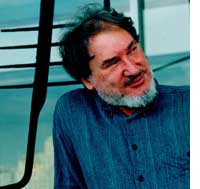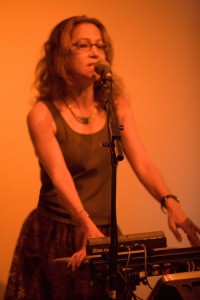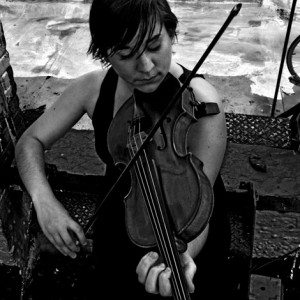My article today in Musical America reviews the NY Philharmonic’s Contact! Concert on 12/16 at the Met Museum. While I enjoyed the music – hearing HK Gruber perform Frankenstein!! was a particular treat – I took issue with the announcement at the event of Alan Gilbert being awarded Columbia University’s Ditson Prize, which recognizes a conductor for his advocacy for American composers. This season, the Contact! series includes only one American: Elliott Carter. It’s a far cry from their inaugural season just two years ago, when they featured Sean Shepherd, Nico Muhly, Arlene Sierra, and others. Perhaps Maestro Gilbert will take the opportunity of being acknowledged for past programming decisions to reinvest future seasons of Contact! with a commitment to emerging American composers.
 For a few different takes on reality, you ought to go check out FIVE POINTS, a collaboration between PULSE Composers Collective and TAKE dance: “a true marriage of contemporary dance and music inspired by the senses and synesthesia.”
For a few different takes on reality, you ought to go check out FIVE POINTS, a collaboration between PULSE Composers Collective and TAKE dance: “a true marriage of contemporary dance and music inspired by the senses and synesthesia.”
Five composers, five pieces, five dances!
Joseph C. Phillips Jr. founded the composer federation Pulse in 2004 with composers who shared a desire to create and perform music that has no rigid divisions or categories, and I was lucky enough to ask him a few questions about FIVE POINTS, the second collaboration between these two groups:
1) When you write for a choreographer, do you have dancers and movement in mind, or are you just leaving it up to the dancers to work with the sound world you create?
Since much of my music is quite rhythmic, movement is often directly linked to it, whether for dance or not. Some of my best pieces begin with me dancing or moving as I am composing it and I often imagine people groovin’ to something I have written. When writing specifically for dance, I do imagine what types of motion or movement might be appropriate for the music, but don’t usually suggest this to the choreographer. I have worked with three different dance companies and four choreographers over the years and each experience is a bit different but I am always surprised, however, when I see the actual choreography and how differently the movement is to what I thought it might be, but also how well it works with the music.
2) Along that line, how much involvement did you have with the Kile Hotchkiss? Did you know that the dance would be for six female dancers and did the choreographer have any particular requests for you?
For last year’s project, Take and I randomly picked composers and choreographers to work together. This year we just assigned people, so I knew what Kile was capable of from last year’s wonderful piece with Darcy James Argue. I wanted to have a contrast with my composition from last year, which was a slower, more contemplative work with Take choreographing, but also something a little different musically from what Kile worked with last year. So starting this summer Kile and I mostly emailed back and forth, I told him my broaden thoughts on synesthesia (actualized sound through movement, as representative from the disco era) and he shared his (Cymatics, the visual representation of sound either in wave patterns or material substances). We talked a little about how the piece would “feel” and from there it was straight-forward: I would send sound file sketches, he would offer feedback on how the choreography might work with music, I would keep going or make changes (sometimes I would resist certain changes on musical grounds, in which we would compromise a solution). In the process, Kile mention the dance was all-female (which was helpful to know and visualize as I was creating) and did have a few specific request about certain sections of the music (a little too “cheery” here, maybe more “fierce” there, can the ending be extended slightly), but overall the process was smooth and very collaborative.
3) After the music and choreography were finished, was there much dialog and revision based on the visions of composer v. choreographer?
Since we were communicating throughout the composing/early choreographing phases, any revisions and editing happened before the piece was fully finished so it already matched our conception once completed.
4) The whole program has a “synesthesia” theme: Do you have synesthesia, and if so, what kind?
No, I am not officially a synesthete. Although like many people, I have experienced aspects of synesthesia.
5) And-your piece, “The Substance of Things Unseen,” is said to create “adventitious synesthesia.” Can you speak a little bit about what this is and how the music and dance work together to create this experience?
Adventitious synesthesia is when the heighten perceptional experiences are artificially induced rather than produced by genetic causes. My composition, which is actually titled “Unlimited” (the dance is “The Substance of Things Unseen”), was inspired by both my thoughts and feelings about a particular passage on disco in the 1995 PBS/BBC documentary “Rock and Roll” and Kile’s research into cymatics. The movement Kile created for “The Substance of Things Unseen” is very dynamic and exciting and while he does not take my disco concept literally, the joy in motion and movement of one’s body, which I associate with the disco era, is certainly present. The music is constantly driving and pushing and Kile creates movement that is just as forceful and energetic. I thought about dance as visualized sound and how for dancers particular sounds might mean particular gestures (how one’s “head and neck do things it didn’t know it could do” based on hearing a groove or rhythm) or how being on the dance floor might induce a specific heighten feeling, and I wanted to create music that reflected those thoughts.
6) How do you feel all the pieces interact together? Is there one cohesive narrative through the evening or will the audience experience vignettes?
While there is no overall narrative in FIVE POINTS, there is a good sense of balance in the program, with all of the pieces bringing together different perspectives on synesthesia; there are large ensemble pieces, a quirky and humorous one, and quieter emotive pieces. Each piece is a world unto itself like a collection of short stories on a overriding subject, with the composers and choreographers creating some fascinating images and sounds. Pulse and TAKE Dance work quite well together (and as a composer it is so stimulating to see your music danced to) and hopefully there will be a TAKE DANCE + Pulse: Part 3!
For TAKE DANCE + Pulse Part 2, head on over to Merce Cunningham Dance Studios, 55 Bethune Street
DEC 15-16 @ 9:00PM, DEC 17th @ 8:00PM
 Cory Smythe and Amy X Neuburg; Photos courtesy of Glenn Cornett
Cory Smythe and Amy X Neuburg; Photos courtesy of Glenn Cornett
Amy X Neuburg/Cory Smythe
Roulette
Brooklyn, NY
Dec. 13, 2011
It’s East Meets West…coast, that is.
On the stage of the old-school charming Roulette in Brooklyn was yet another creatively edgy program, put on this time by the pairing of West-coast avant-cabaret artist Amy X Neuburg and New York’s own pianist-composer, ICE’s Cory Smythe. Presented without an intermission, the show was almost entirely electronic or electro-acoustic in nature (with the exception of a refreshing burst of Fats Waller’s “Handful of Keys” from Mr. Smythe), and most of the pieces were composed and/or arranged by both of them. (more…)
 HK Gruber has a cold. The nasal voice dripping into my telephone earpiece from his home in Vienna sounds more like an early-round contestant on Frog Idol than the celebrated Austrian composer and frequent chansonnier of Frankenstein!!, one of the most unusual and beloved pieces of contemporary music you’re likely to encounter. In the chansonnier role, the performer is required to sing in cabaret, lieder and exaggerated operatic styles as well as speak, whisper and shriek at the top of his lungs. All of which, Gruber does extremely well if you’ve heard a recording or seen him perform.
HK Gruber has a cold. The nasal voice dripping into my telephone earpiece from his home in Vienna sounds more like an early-round contestant on Frog Idol than the celebrated Austrian composer and frequent chansonnier of Frankenstein!!, one of the most unusual and beloved pieces of contemporary music you’re likely to encounter. In the chansonnier role, the performer is required to sing in cabaret, lieder and exaggerated operatic styles as well as speak, whisper and shriek at the top of his lungs. All of which, Gruber does extremely well if you’ve heard a recording or seen him perform.
Will his congested state affect his upcoming performances of Frankenstein!! with the New York Philharmonic at the Metropolian Museum on December 16 and Symphony Space on December 17, I wondered? “Not at all,” he says. “It might make them more even more interesting. This is not the kind of role that demands much serious singing.”
Even via transatlantic cable you can tell that HK Gruber is a man who enjoys his work and clearly doesn’t take himself all that seriously. As a composer, he’s been pulling the beards of Schoenberg and the other Gods of the Second Viennese School for well over 40 years now. Born in Vienna in 1943, Gruber was a member of the Vienna Boys’ Choir and at the Vienna Hochschule für Musik studied composition with Erwin Ratz and Gottfried von Einem, theory with Hanns Jelinek and double bass with Ludwig Streicher. From 1961 he played double bass with the ensemble ‘die reihe’ and from 1969 with the ORF-Symphony Orchestra. Since 1997 he has devoted himself to composing, conducting and performance as chansonnier.
Gruber’s heroes were not the atonal gang of the Second Viennese School but composers like Kurt Weill and Hans Eisler whose music mined popular musical forms like caberet to create theater pieces often set to Bertolt Brecht’s subverisve lyrics. Not that Gruber dislikes gnarlier works by more formal composers. His music theatre repertoire also includes Schoenberg’s Pierrot Lunaire, Maxwell Davies’s Eight Songs for a Mad King, and works by Kagel.
The origin of the Frankenstein!!, a pan-demonium for chansonnier and orchestra after children’s rhymes by H.C. Artmann dates back to the Frankenstein Suite of 1971 — a sequence of songs and dances written for the Vienna ‘MOB art and tone ART Ensemble’, a group of young art and music radicals that included fellow composers Kurt Schwertsik and Otto Zykan which was then active in the field of instrumental theatre. “We had this radical idea that harmony could be pretty nice. Everything didn’t have to be atonal. Of course, they referred to us as those ‘Viennese Clowns.'” He sounds positively pleased.
Gruber was unhappy with the improvisatory structure of the original and felt it required a full orchestra so in 1976/77 he completely recomposed the work in its present form and convinced a promising young conductor named Simon Rattle to take it on. It was first performed on November 25, 1978 by the Royal Liverpool Philharmonic Orchestra, with Gruber himself as soloist. For the 1979 Berlin Festival he wrote an alternative version for soloist and 12 players. Since then, the two versions have been performed literally hundreds of times and Gruber has recorded them both–as chansonnier with the Camerata Academica Salzburg, led by Franz Welser-Möst for EMI, and as both singer and conductor with the BBC Philharmonic for Chandos
“The title of the volume from which I took the poems of Frankenstein!! – Allerleirausch, neue schöne kinderreime (Noises, noises, all around – lovely new children’s rhymes) – sounds naive and innocently cheerful; but H.C. Artmann described the poems as being, among other things, ‘covert political statements.’ He refused to explain what he meant but we all know from history that the monsters of political life have always tried to hide their true faces, and all too often succeed in doing so”
Gruber believes one of the reasons for Frankenstein’s endurance is that it works one one level for kids and on another for adults. And who of any age could resist an orchestral work that requires nearly all the orchestra players to double on toys of various kinds. Including a plastic hose; a “bird warbler” (a short plastic or metal pipe on a string, swung like a lasso); and an automobile horn (vintage 1910, the score suggests); a toy car horn; toy clarinets, saxophones, trumpets and piano paper bags and a set of variously pitched swanee whistles, made of tubing with a recorder mouthpiece and a plunger that allows the player to produce glissandos.
Despite Frankenstein!!’s extraordinary popularity, Gruber is far from a one-hit wonder. He is particularly noted for his concertos, including Aerial for trumpeter Håkan Hardenberger, which has received over 40 performances since its premiere in 1999, two for violinist Ernst Kovacic, the Cello Concerto written for Yo-Yo Ma and premiered at Tanglewood in 1989, the percussion concerto Rough Music in the repertoire of Evelyn Glennie, and Busking for trumpet, accordion, banjo and string orchestra, premiered by Hardenberger in 2008. His dramatic works include the apocalyptic opera Gomorra staged at the Vienna Volksoper in 1993, Gloria, a musical version of Rudolf Herfurtner’s classic pigtale, staged at the 1994 Huddersfield Contemporary Music Festival, Munich Volkstheater, Wien Modern festival, Munster Theater and the Aspen Music Festival, and Der Herr Nordwind to a libretto by HC Artmann, premiered at Zürich Opera in 2005.
He is currently at work on an opera based on Ödön von Horváth’s play Tales From the Viennese Woods which as a subject is as far afield as one can get from the gay Strauss waltz from which it takes its name. A woman named Marianne seeks to escape the brutality of petit bourgeois life on “a quiet street in Vienna’s Eighth District” but is stifled by a conspiracy of her miserable neighbors. Gruber likens her to a female Wozzeck.
But, for now, there is the durable Frankenstein!! with the New York Philharmonic at the Metropolitan Museum of Art of December 16 and the following night at Symphony Space. Also on the program are Fibers, Yarn and Wire by Alexandre Lunsqui and Gran Duo by Magnus Lindberg. Details are here.
I have three sets of tickets for the December 17 performance at Symphony Space. Here’s your tossup. Name a famous American composer who has sung the role of chansonnier in Frankenstein!! Or, name a famous American conductor who has sung the role. I’ll pick the winners out of hat if several people get it right.

Elliott Carter is 103. The only composer who lived longer: Leo Ornstein. But Ornstein stopped composing at 97: Carter is still going.
On Thursday evening, in a concert at the 92nd Street Y organized by cellist Fred Sherry, seven works written since Carter’s 100th birthday were given their world or US premieres. Astounding.
On Tuesday, December 13, Bay-area artist Amy X Neuburg will collaborate for one-night only with NY-based pianist/composer Cory Smythe at Brooklyn’s Roulette on Atlantic Ave.
Neuburg’s brand of music, which has been dubbed “avant-cabaret”, promises to be an interesting blend with Smythe’s improvisational work as they will play a majority of the evening together, as well as some portions solo.
Amy told us recently in an interview what to look forward to in this unique show:
We’re each performing a few solo songs, but the bulk of the evening will be brand new and collaborative. Much of our music leaves room for improvisation, and most of it involves live looping of the piano and the voice. You’ll hear a “cabaret improv” song about rat experiments, a completely whack song Cory has written which I am to sing in a country twang while looping piano chords in multiple odd time signatures, a duo of new songs (about personality disorders) constructed of simple layered lines, two composed songs that we played earlier this year in Milwaukee, and an unusual interpretation of “Gretchen am Spinnrade” that we have convinced ourselves Mr. Schubert would appreciate.

Congratulations to:
Kyle Lynch
Ulysses Tone
Everette Minchew
Mark Wilson
Winners, please send me a quick email with your preferred mailing address.
Best,
Christian
Courtesy of Boosey and Hawkes, Bridge Records, and Naxos Records, we have another special giveaway that will benefit those not able to attend Elliott Carter’s 103rd birthday party on Thursday in New York.
We’re giving away two signed CDs of “Music of Elliott Carter: volume 5” (Bridge 9128), and two of String Quartets Nos. 2, 3 and 4 (featuring the Pacifica Quartet; Naxos 8.559363), along with a signed 8×10 photo to accompany each.
Once again, I’ll be selecting the winners via a random drawing. If you’re interested, send me an email at: S21managingeditor@gmail.com. The contest will be open until noon on Thursday.
Hi, All.
We’re giving entrants another day to put in for the Carter ticket giveaway, extending the deadline until tomorrow (Monday).
All we need is your name and a brief (a sentence or two) statement about Carter.
Check back Monday evening for our next giveaway: memorabilia signed by Elliott Carter!
“I always describe the viola as something that is kind of the wrong size for its body. It sounds like a man singing very high or a woman singing very low. And there’s something about that in-between-ness that is very attractive to me and the challenge of overcoming the fact that, physics-wise, it’s actually proportioned incorrectly, in other words, for a viola to be the right size for the length of its strings to play very easily, it would be something like the size of a small cello…There’s something about reaching in and having to get around that imperfection that really appeals to me, honestly.” (more…)



